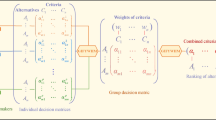Abstract
A standard lower-side attainment values based inexact fuzzy two-stage programming (SLA-IFTSP) approach is proposed for supporting multi-water resources management under multi-uncertainties. The method improves upon the existing inexact two-stage stochastic programming by the introduction of a standard average lower-side attainment values based fuzzy linear programming. Multi-uncertainties such as intervals, probabilistic and/or possibilistic distributions and their combinations in water resources management can be directly communicated into the water allocation process. The risk of infeasibility caused by the random water availabilities can be analyzed by imposing economic penalties when the designed water allocations would not be satisfied after the occurrence of random seasonal flows. Based on the standard average lower-side attainment index, the fuzzy random relationships representing various subjective judgments in the model can be transformed into corresponding deterministic ones without additional constraints, and thus guarantee a higher computational efficiency. A hypothetical case regarding two-source water resources management is adopted for demonstrating its applicability. Reasonable solutions have been generated. They provide desired water allocations with maximized system benefit under different water availability levels. The solutions of intervals with different probabilities can be used for generating decision alternatives. Comparisons between the solutions from SLA-IFTSP and those from ITSP are also undertaken. They show that SLA-IFTSP can generate more reasonable water allocation patterns with higher net system benefits than ITSP.







Similar content being viewed by others
Abbreviations
- f :
-
Net system benefit ($)
- B j :
-
Benefit for allocating per unit of water to user j
- T mj :
-
Allocation target promised to user j by surface reservoir m (the first-stage decision variable)
- T nj :
-
Allocation target promised to user j by local river n (the first-stage variable)
- C j :
-
Penalty cost for per unit of water not delivered to user j
- q m :
-
Fuzzy random variable being equal to available water amount of reservoir m
- q n :
-
Fuzzy random variable being equal to available water amount of local river n
- D mjkh :
-
Amount by which water-allocation target T mj is not met when the inflow of reservoir m is h level
- D njkh :
-
Amount by which water-allocation target T nj is not met when the inflow of local river n is h level
- θ mj :
-
Variation factor representing water losses in the allocating stage from reservoir m to user j
- θ nj :
-
Variation factor representing water losses in the allocating stage from local river n to user j
- J :
-
Index for users
- M :
-
Index for reservoir
- n :
-
Index for local river
- k :
-
Index for planning periods
- H j :
-
Maximum total water shortage for user j over the planning horizon
- G k :
-
Maximum total water shortage for all users during each planning period
- BR minj :
-
Minimum water demand of user j
- BR maxj :
-
Maximum water demand of user j
References
Chiang J (2001) Fuzzy linear programming based on statistical confidence interval and interval-valued fuzzy set. Eur J Oper Res 129(1):65–86. doi:10.1016/s0377-2217(99)00404-x
Chou SY, Lin JSJ, Julian P (2009) A note on solving linear programming problems under fuzziness and randomness environment using attainment values. Inform Sci 179(23):4083–4088. doi:10.1016/j.ins.2009.08.013
Croft HT, Falconer KJ, Guy RK (1991) Unsolved problems in geometry. Springer
Fan YR (2008) Inexact optimization methods and their application to solid waste management system. MD dissertation, North China Electric Power University
Fortemps P, Roubens M (1996) Ranking and defuzzification methods based on area compensation. Fuzzy Set Syst 82(3):319–330. doi:10.1016/0165-0114(95)00273-1
Guo P, Huang GH (2009) Two-stage fuzzy chance-constrained programming: application to water resources management under dual uncertainties. Stoch Environ Res Risk Assess 23(3):349–359. doi:10.1007/s00477-008-0221-y
Guo P, Huang GH, He L, Zhu H (2009) Interval-parameter two-stage stochastic semi-infinite programming: application to water resources management under uncertainty. Water Resour Manag 23(5):1001–1023. doi:10.1007/s11269-008-9311-3
He L, Huang GH, Lu HW (2008) A simulation-based fuzzy chance-constrained programming model for optimal groundwater remediation under uncertainty. Adv Water Resour 31(12):1622–1635
Hoppe H, Weilandt M, Orth H et al (2004) A combined water management approach based on river water quality standards. J Environ Inform 3(2):67–76. doi:10.3808/jei.200400028
Huang GH (1996) IPWM: an interval parameter water quality management model. Eng Optim 26(2):79–103
Huang GH, Chang NB (2003) The perspectives of environmental informatics and systems analysis. J Environ Inform 1(1):1–7. doi:10.3808/jei.200300001
Huang GH, Loucks DP (2000) An inexact two-stage stochastic programming model for water resources management under uncertainty. Civ Eng Environ Syst 17(2):95–118. doi:10.1080/02630250008970277
Huang GH, Baetz BW, Patry GG (1995) Grey integer programming: an application to waste management planning under uncertainty. Eur J Oper Res 83(3):594–620. doi:10.1016/0377-2217(94)00093-R
Huang GH, Li YP, Xiao HN, Qin XS (2007) An inexact two-stage quadratic program for water resources planning. J Environ Inform 10(2):99–105. doi:10.3808/jei.200700104
Inuiguchi M, Sakawa M (1998) Robust optimization under softness in a fuzzy linear programming problem. Int J Approx Reason 18(1–2):21–34. doi:10.1016/S0888-613X(97)10002-0
Jacobs JM, Vogel RM (1998) Optimal allocation of water withdrawals in a river basin. J Water Resour Plan Manage 124(6):357–363
Jamison KD, Lodwick WA (2001) Fuzzy linear programming using a penalty method. Fuzzy Set Syst 119(1):97–110. doi:10.1016/S0165-0114(99)00082-2
Jiménez M, Arenas M, Bilbao A, RodrIīguez M (2007) Linear programming with fuzzy parameters: an interactive method resolution. Eur J Oper Res 177(3):1599–1609
Li YP, Huang GH (2008) Interval-parameter two-stage stochastic nonlinear programming for water resources management under uncertainty. Water Resour Manag 22(6):681–698
Li YP, Huang GH (2009) Two-stage planning for sustainable water-quality management under uncertainty. J Environ manage 90(8):2402–2413. doi:10.1016/j.jenvman.2008.11.007
Li YP, Huang GH, Nie SL (2006) An interval-parameter multi-stage stochastic programming model for water resources management under uncertainty. Adv Water Resour 29(5):776–789. doi:10.1016/j.advwatres.2005.07.008
Liu BD (2001a) Fuzzy random chance-constrained programming. IEEE Trans Fuzzy Syst 9(5):713–720. doi:10.1109/91/.963757
Liu BD (2001b) Fuzzy random dependent-chance programming. IEEE Trans Fuzzt Syst 9(5):721–726. doi:10.1109/91/.963758
Liu XW (2001c) Measuring the satisfaction of constraints in fuzzy linear programming. Fuzzy Set Syst 122(2):263–275
Liu ZF, Huang GH (2009) Dual-interval two-stage optimization for flood management and risk analyses. Water Resour Manag 23(11):2141–2162. doi:10.1007/s11269-008-9375-0
Liu BD, Liu YK (2002) Expected value of fuzzy variable and fuzzy expected value models. IEEE Trans Fuzzy Syst 10(4):445–450. doi:10.1109/TFUZZ.2002.800692
Lu HW, Huang GH, Zeng GM, Maqsood I, He L (2008) An inexact two-stage fuzzy-stochastic programming model for water resources management. Water Resour Manag 22(8):991–1016. doi:10.1007/s11269-007-9206-8
Lu HW, Huang GH, He L (2009) Inexact rough-interval two-stage stochastic programming for conjunctive water allocation problems. J Environ manage 91(1):261–268. doi:10.1016/j.jenvman.2009.08.011
Luhandjula MK (1996) Fuzziness and randomness in an optimization framework. Fuzzy Set Syst 77(3):291–297. doi:10.1016/0165-0114(95)00043-7
Luhandjula MK (2004) Optimisation under hybrid uncertainty. Fuzzy Set Syst 146(2):187–203. doi:10.1016/j.fss.2004.01.002
Luhandjula MK, Gupta MM (1996) On fuzzy stochastic optimization. Fuzzy Set Syst 81(1):47–55. doi:10.1016/0165-0114(95)00240-5
Luo B, Maqsood I, Yin YY, Huang GH, Cohen SJ (2003) Adaption to climate change through water trading under uncertainty—an inexact two-stage nonlinear programming approach. J Environ Inform 2(2):58–68. doi:10.3808/jei.200300022
Maqsood I, Huang GH, Yeomans JS (2005) An interval-parameter fuzzy two-stage stochastic program for water resources management under uncertainty. Eur J Oper Res 167(1):208–225. doi:10.1016/j.ejor.2003.08.068
Mujumdar P, Sasikumar K (2002) A fuzzy risk approach for seasonal water quality management of a river system. Water Resour Res 38(1):5-1
Nandalal KDW, Sakthivadivel R (2002) Planning and management of a complex water resource system: case of Samanalawewa and Udawalawe reservoirs in the Walawe River, Sri Lanka. Agric Water Manage 57(3):207–221. doi:10.1016/S0378-3774(02)00070-7
Needham JT, Watkins DW Jr, Lund JR, Nanda SK (2000) Linear programming for flood control in the Iowa and Des Moines rivers. J Water Resour Plan Manage 126(3):118–127. doi:10.1061/(ASCE)0733-9496(2000)126:3(118)
Prasad AS, Umamahesh NV, Viswanath GK (2006) Optimal irrigation planning under water scarcity. J Irrig Drain E 132(3):228–237. doi:10.1061/(ASCE)0733-9437(2006)132:3(28)
Qin XS, Huang GH, Zeng GM, Chakma A, Huang YF (2007) An interval-parameter fuzzy nonlinear optimization model for stream water quality management under uncertainty. Eur J Oper Res 180(3):1331–1357
Qin XS, Huang GH, Li YP (2008) Risk assessment of BTEX contamination in ground water—an integrated fuzzy approach. Ground Water 46(5):755–767
Ramík J, Rímánek J (1985) Inequality relation between fuzzy numbers and its use in fuzzy optimization. Fuzzy Set Syst 16(2):123–138. doi:10.1016/S0165-0114(85)80013-0
Rommelfanger H (1996) Fuzzy linear programming and applications. Eur J Oper Res 92(3):512–527
Shangguan ZP, Shao MG, Horton R, Lei TW, Qin L, Ma JQ (2002) A model for regional optimal allocation of irrigation water resources under deficit irrigation and its applications. Agric Water Manage 52(2):139–154. doi:10.1016/S0378-3774(01)00116-0
Tan Q, Huang GH, Cai YP (2010) Identification of optimal plans for municipal solid waste management in an environment of fuzziness and two-layer randomness. Stoch Environ Res Risk Assess 24(1):147–164. doi:10.1007/s00477-009-0307-1
Tsakiris G, Spiliotis M (2004) Fuzzy linear programming for problems of water allocation under uncertainty. Eur Water 7/8:25–27
Van Hop N (2007a) Solving fuzzy (stochastic) linear programming problems using superiority and inferiority measures. Inform Sci 177(9):1977–1991. doi:10.1016/j.ins.2006.12.001
Van Hop N (2007b) Solving linear programming problems under fuzziness and randomness environment using attainment values. Inform Sci 177(14):2971–2984. doi:10.1016/j.ins.2007.01.032
Xu Y, Huang GH, Qin XS (2009) Inexact two-stage stochastic robust optimization model for water resources management under uncertainty. Environ Eng Sci 26(12):1765–1776. doi:10.1089/ees.2009.0212
Zimmermann HJ (2001) Fuzzy set theory–and its applications. Springer Netherlands, Dordrecht
Acknowledgments
This research has been supported by the Major Science and Technology Program for Water Pollution Control and Treatment (2009ZX07104-004). The authors are grateful to the editors and the anonymous reviewers for their insightful comments and suggestions.
Author information
Authors and Affiliations
Corresponding author
Rights and permissions
About this article
Cite this article
Hu, Q., Huang, G., Liu, Z. et al. Inexact fuzzy two-stage programming for water resources management in an environment of fuzziness and randomness. Stoch Environ Res Risk Assess 26, 261–280 (2012). https://doi.org/10.1007/s00477-011-0503-7
Published:
Issue Date:
DOI: https://doi.org/10.1007/s00477-011-0503-7




